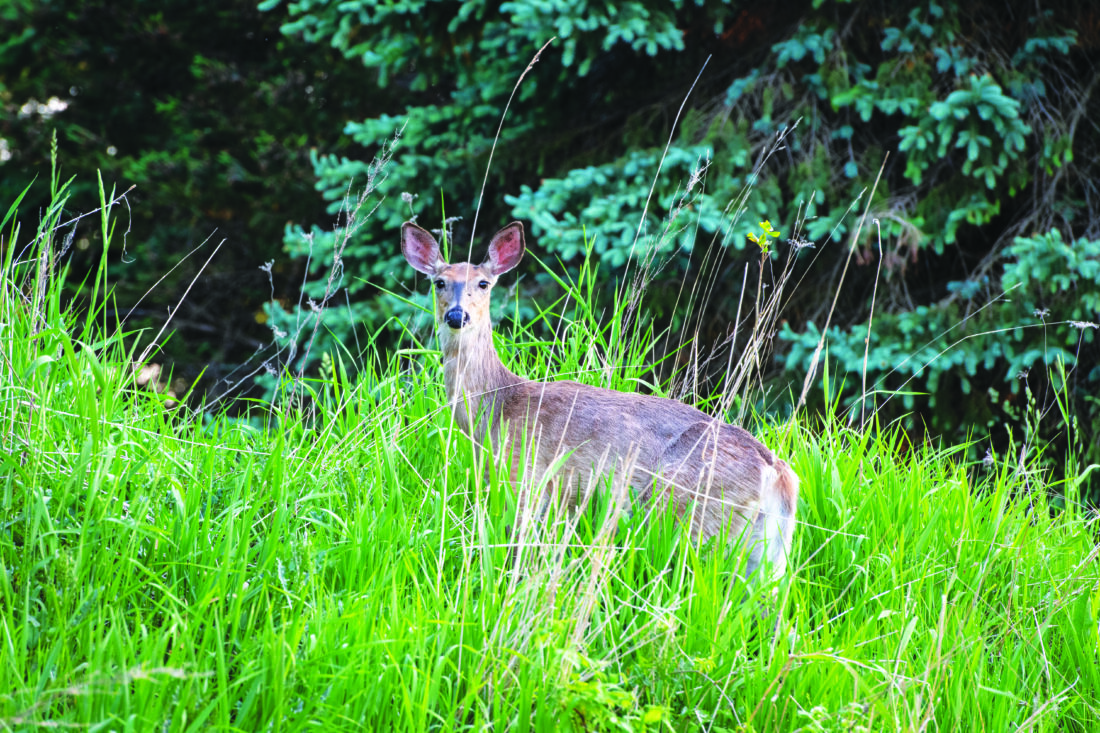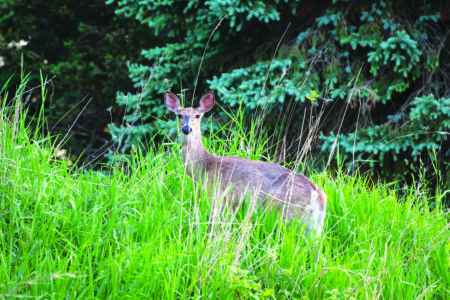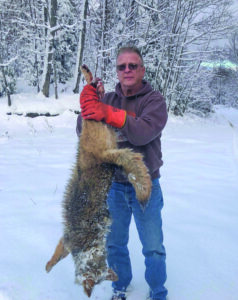Reasons for change
Anterless deer added to some deer seasons

Photo provide by Michigan DNR Antlerless deer will be permitted to harvest during the 2025 Archery season with a doe tag.
UPPER MICHIGAN — Antlerless deer will be available to hunt during some of the upcoming deer seasons for the first time in about ten years. The changes affect areas in Lake Superior watershed in the U.P. The Lake Superior watershed is comprised of the counties, from Gogebic in the west, to Chippewa in the east that border Lake Superior. Houghton, Keweenaw, Baraga and Ontonagon counties are included in the area affected by the changes. The new regulations affect the Liberty hunts and Independence hunts, which are shorter firearm seasons for youth and those with disabilities, and keeps the ability to harvest bucks. The official changes were implemented in May during the Natural Resource Commission meeting. The changes come after research and collaboration between several groups such as the Michigan DNR and the Upper Peninsula Deer Advisory Team.
2025 Archery season, which spans from Oct. 1 to Nov. 14, doe tag options are available with the late season spanning from Dec. 1,, 2025 to Jan. 1 2026. Education on the importance of harvesting antlerless deer has also been incorporated into hunter safety.
In 2015 the Natural Resource Commission removed the option to harvest does during the archery season in the Lake Superior watershed following concerns of the population decline due to harsh winters in 2013 and 2014. Upper Peninsula Deer Advisory Team Chairman Jordan Hoover said the chain of thought at the time was the more does were spared, the more births would occur.
“Unfortunately, biologically, that’s just not how that works over a span of time,” Hoover said. “It’s not that simple, but there was good intentions. So unfortunately, we have suffered a devastating cascade of issues biologically in the Superior watershed resulting from that decision, the first one is heightened Buck mortality rate.”
DNR Service and Wildlife Interactions Unit Supervisor Chad Stewart said since the removal of antlerless deer from the hunts, the herd number has remained low. Stewart is familiar with the makeup of buck to doe ratios for deer herds in Michigan due to his experience as the Deer, Elk and Moose Management Specialist. Stewart explained the does of the area all come into estrus, or heat, around the same time which allows bucks to breed.
“That allows for timing of fawn drop in the optimal part of summer when the forage is the greatest, and that can support lactating females giving fawns as much opportunity to grow and put on weight going into the winter,” Stewart said.
Stewart said only harvesting bucks have skewed the sex ratios and some of the does that were not bred will come into estrus a second or third time. Delayed breeding leads to later births which limits their growing period during the summer, which will leave those fawns to be smaller and ill prepared to survive their first winter.
“They’re at a disadvantage. So what has been seen in some places and communicated from a lot of hunters is that there is a skewed sex ratio. They’ve seen spotted fawns going into winter, [and] those fawns don’t have a very good chance to survive. What we tend to see is the sex ratios most skewed after severe winters and we have some data that supports that,” Stewart said.
Hoover said lower numbers of fawn in the spring mean the predation rate will be higher. He referred to a study done by Mississippi State University in collaboration with the Michigan DNR which found the predation success on fawns to be significantly high.
“If a coyote walks into a thicket and one fawn goes left or one fawn goes right, he’s gonna pick one and he’s probably gonna get one. Now, if he walks into that same thicket and 10 fawns go blowing out of there every which way, he’s probably not gonna get any. It’s kind of a target acquisition issue. So that was the theory from Mississippi State: higher depredation loss,” Stewart said.
Milder winters allow the deer population to attempt a balancing of the sex ratio. Stewart said the introduction of does into the three hunts will not have a significant impact on the herd, but assist in balancing the sex ratios.
“It’s going to provide a lot more flexibility for hunters, especially archery hunters, and how they use the tag, and I think it will have a chance to balance those sex ratios in localized areas where they may be skewed so hunters can make their appropriate harvest decisions that are appropriate to the area that they’re hunting in,” Stewart said.
Hoover said the imbalance between the sexes also puts breeding stress on bucks, and during winter when far less food is available to them they are at a continuous caloric loss and many die in January and February.
“They’re either succumbing to depredation because they’re too weak to flee or defend themselves, or else they die of starvation. You hear a lot of guys say over the years, ‘Well, we just don’t have the big bucks like we used to.’ Well, this is a factor in that, because they’re literally running themselves to death,” Hoover said.
Another reason for the low deer population Hoover brought up was the carrying capacity for the whitetail deer, which is the amount of resources in a habitat area which can support a healthy deer population. Once the number of deer is beyond carrying capacity for the area, the population suffers because there are not enough resources for each deer. Hoover used the example of pouring more coffee into a cup than it can carry, which results in the coffee overflowing.
“There’s one thing in the Upper Peninsula and one thing only that governs carrying capacity, and that’s the condition of our DWCs, or deer winter complex (some people call them deer yards). We have a tremendous habitat issue pursuant to our deer yards. At one time, we had 122 uniquely identified deer winter complexes. Today, we only have 36. Of the 36 that remain, only six are meeting sufficient food and shelter metrics, according to the DNR, so 30 out of 36 are failing. We’ve got some serious issues. So knowing that basically it boils down to this, 100 percent of the deer are cramming into 15 percent of the habitat for the winter, you begin to see the issue,” Hoover said.
While balancing the sex ratio may assist in the deer population, Hoover believes the carrying capacity needs to also be increased, which can be achieved though habitat improvement. Hoover said this process will take time and money, and must be a collaborative effort between industrial and private landowners in key areas, the DNR and U.S. Forest Service.
Natural Resource Commission Chair Beck Humphries said the Lake Superior Watershed has a smaller carrying capacity compared to other areas of Michigan, and the harvesting of does may also assist in balancing the carrying capacity. She said the watershed is probably carrying too many does, which led to the Commission feeling the hunting season for antlerless deer was warranted.
Following the deer season, the DNR will observe the total harvest and document the number of does taken and then break the numbers down by specific deer management unit levels.
“We’ll look at the ratio of the impacts such as how many antlered deer are being taken, how many antlerless deer are being taken. Of those antlerless deer, what type of antlerless deer are being taken as reported by hunters? So are they adults? Those are they button bucks? Are they shed bucks? Are they female fawns?” Stewart said.
Stewart emphasized these are the reasons why it is vital for hunters to report their harvests to the DNR at check-in stations. He said the DNR will be provided with information which will allow them to see how many does are taken per square mile, which will then be quantified and scale the level of the hunt’s impact which can be used for future evaluations. This data can allow the hunts to continue or provide evidence for regulation course correction. These studies would not be implemented for the entire region of the U.P., but instead individual units.
Humphries said the reintroduction of the antlerless hunts and retaining the ability to hunt bucks in the Liberty and Independence hunts will be good not only for the deer population, but also hunters.
“We were hearing from both mentors and folks from those groups (Liberty and Independence hunters) that they felt they were curtailed in their opportunities to get out. When I grew up, deer hunting meant schools shut down, and there was not all the constraints on the time that we have today. And so we want to make as good a use of those opportunities to get youth out in the field, and also those individuals who are in Liberty hunt, have an opportunity to get out and be successful,” Humphries said.
Humphries explained the way to get the youth interested in conservation is to have them involved in activities such as hunting, and they will be needed to carry on the work to keep nature healthy.






